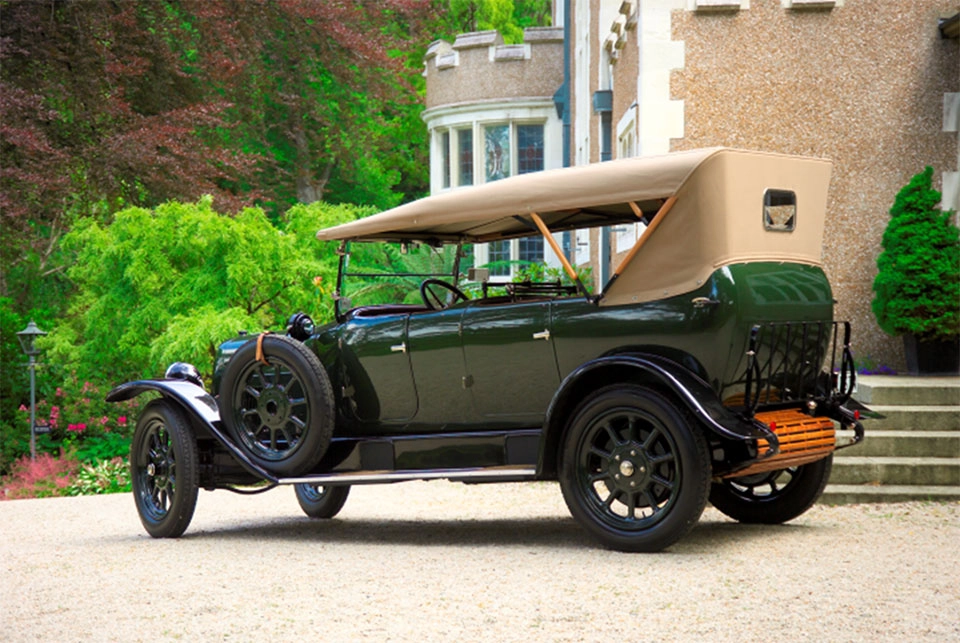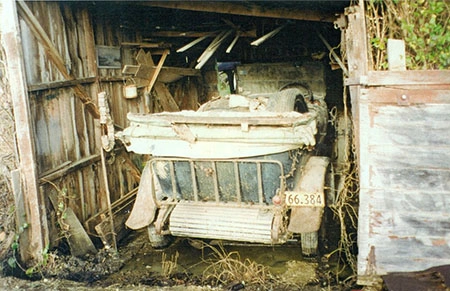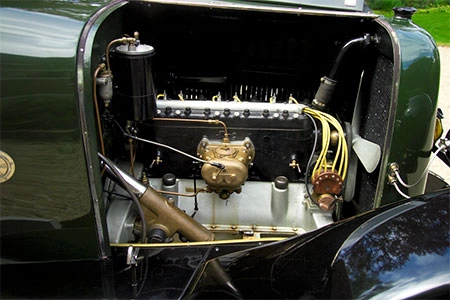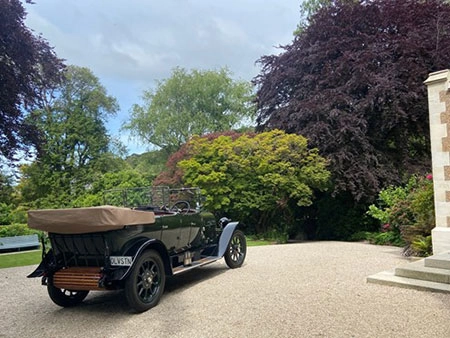 Olveston’s 1921 Fiat Tipo 510 .
Olveston’s 1921 Fiat Tipo 510 .
Mention Fiat vehicles and most would immediately think of 1950-70s Fiat’s cheerful 500 series super-mini cars and not a gracious touring car from the 1920s or even Fiat company’s amazing racing heritage.
The Theomin’s Fiat Tipo (type) 510 is a 1921 model with a colonial built four-door Torpedo tourer 5-seater body and substantial folding canvas top and side screens, and for the rear passengers a fold up Auster Screen. It was the largest car in the post-First World War Fiat range and was equipped with a six-cylinder motor. Fitted with a fine finished and comfortable body, as this one is, these powerful cars were capable of travelling up to sixty miles within the hour.
With many of Dunedin city’s streets being steep, this big Fiat would have made easy work of them as the gearing is ideally suited.
The choice of a large and fairly expensive product of Italy as a family car showed David Theomin’s interest in the finer things of life.
After the war the Fiat range of cars was marketed by the local Dunedin dealer W.J.P McCulloch who operated initially close to the Theomin Piano Business in Princes Street before moving to premises in lower Stuart Street.
Fine cars were imported from several European manufacturers before punishing import duties introduced in the 1930s restricted the range to products from the British Empire.
Interesting Note
The Theomin’s were in good company! At the same time in Italy, a Tipo 510 Tourer was the choice of transport for the King of Italy, Victor Emmanuel 111, who had his from 1923 to 1929.
This vehicle still exists and was recently sold to a collector.
The Theomin Fiat
The Theomin’s second car was a 1921 Fiat 510 Tourer. Purchased as a chassis, radiator, bonnet, and firewall only in 1921 (imported from Italy) with the body coach-built in Christchurch, NZ to meet the owner’s requirements. It was fitted with side screens, rear screen hood cover and rear luggage carrier. A resident feature at Olveston until the early 1930’s the car was then sold. The Olveston car was driven by the in-house chauffeur who took the family on excursions far and wide.
 Found in a barn
Found in a barn
In July 1994 the Fiat was found in a barn outside Dunedin and taken to dry storage where a full assessment of its condition was carried out. Auto Restorations Ltd, Christchurch completed the restoration work over the next 2-years which involved a total rebuild. The car had been altered over its life and part of the restoration brief to Auto Restorations was to return the car as close to its original 1921 condition as practically possible. After the work was completed in Christchurch the car was driven “Home” with much media fanfare. The car is kept in road ready condition and is motored regularly to keep it alive! The garage built at Olveston was completed in 1914 for the first vehicle (a Veteran 6 Cylinder Buick), which was later replaced by the Fiat.
The Vehicle’s Specifications:
- Model: 1921. Fiat 510 Tourer. This model was manufactured from late 1919 to 1925
- Chassis Number: 0210863
- Engine Number: 0110853
- Body Work: Torpedo body built by coach builders John & Smith of Christchurch.
- Engine: Inline 6 Cylinder side valve; 3446 cc engine producing 46 horsepower or 34kw.
- Transmission: A four speed manual transmission with RHS outer gate change; enclosed driveshaft to rear driving axle.
- Electrics: 12 Volt, Dynamo charging system, electric lighting, electric self-starter, and magneto ignition
- Steering: Worm & Sector type steering box.
 View of the engine
View of the engine
- Brakes: Rear wheels only, Twin expanding brake shoes in the cast iron brake drums, one pair operated by the foot brake pedal and the other by the handbrake lever.
- Wheelbase & wheels: 340 cm (133.9 in) long and fitted with Sankey detachable steel rims with 895 x 135 Beaded Edged tyres. One side mounted spare.
- Curb weight: 1550kg (3420 lb.).
- Touring Speeds: The car is comfortably capable of speeds up to 53 mph or 85 kmph.
The vehicle is quite low geared to assist with Otago’s hilly roads.
Factory Options:
The Fiat Tipo 510 was available in two variants. The standard 510 (which this vehicle is) and the 510S (the sport model with a shorter chassis, Italian built body, Radiator V-shaped and no running boards. Fitted with a slightly more powerful engine producing 53hp or 40kw).
Production numbers of the 510 series were around 13577 built, of which 414 were the 510S version. The model was replaced with the Fiat 512 in late 1925 which had four-wheel brakes and a few other modifications. The body styling also changed to reflect the times.
 Rear view of the Fiat
Rear view of the Fiat
 Explore Olveston room-by-room,
Explore Olveston room-by-room,
